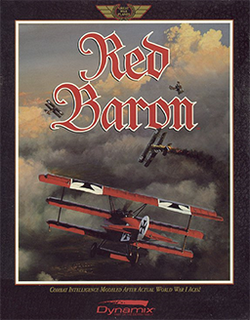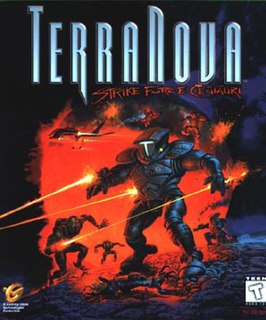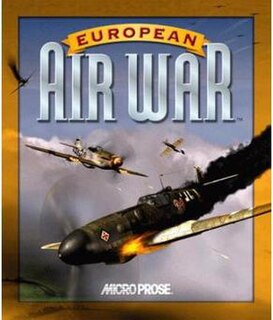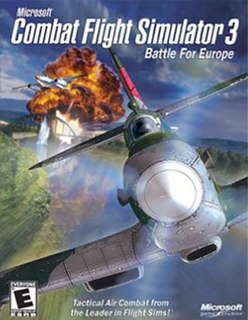
Looking Glass Studios, Inc. was an American video game developer based in Cambridge, Massachusetts. The company was founded by Paul Neurath with Ned Lerner as Blue Sky Productions in 1990, and merged with Lerner's Lerner Research in 1992 to become LookingGlass Technologies. Between 1997 and 1999, the company was part of AverStar, where it was renamed Looking Glass Studios. Following financial issues at Looking Glass, the studio shut down in May 2000. Notable productions by Looking Glass include the Ultima Underworld, System Shock and Thief series.

Red Baron is a combat flight simulation video game for MS-DOS created by Damon Slye at Dynamix. It was published by Sierra On-Line in 1990.

Flight Unlimited is a 1995 aerobatic flight simulator video game developed and published by LookingGlass Technologies. It allows players to pilot reproductions of real-world aircraft and to perform aerobatic maneuvers. They may fly freely, race through floating rings against a timer or take lessons from a virtual flight instructor. The instructor teaches basic and advanced techniques, ranging from rudder turns to maneuvers such as the tailslide, Lomcovák and Immelmann turn.

Flight Unlimited II is a 1997 flight simulator video game developed by Looking Glass Studios and published by Eidos Interactive. The player controls one of five planes in the airspace of the San Francisco Bay Area, which is shared with up to 600 artificially intelligent aircraft directed by real-time air traffic control. The game eschews the aerobatics focus of its predecessor, Flight Unlimited, in favor of general civilian aviation. As such, new physics code and an engine were developed, the former because the programmer of Flight Unlimited's computational fluid dynamics system, Seamus Blackley, had left the company.

Terra Nova: Strike Force Centauri is a 1996 tactical first-person shooter video game developed and published by LookingGlass Technologies. Set in a science-fictional depiction of the 24th century, the game follows a faction of humans who colonize the Alpha Centauri star system to escape from the Hegemony, a totalitarian Earth government. The player assumes the role of Nikola ap Io, the leader of an Alpha Centauri military unit, and undertakes missions against pirates and the Hegemony.

Jonathan "Seamus" Blackley is an American video game designer and former agent with Creative Artists Agency representing video game creators. He is best known for creating and designing the original Xbox in 2001.
Combat flight simulators are vehicle simulation games, amateur flight simulation computer programs used to simulate military aircraft and their operations. These are distinct from dedicated flight simulators used for professional pilot and military flight training which consist of realistic physical recreations of the actual aircraft cockpit, often with a full-motion platform.

Ace Combat 2 is a 1997 air combat video game developed and published for the PlayStation by Namco. It is the sequel to Air Combat and the second in the Ace Combat franchise. The player controls one of 24 different fighter jets through 21 different missions with certain objectives to fulfill, such as protecting a base from enemy fire, intercepting a squadron of enemies, or taking down an aircraft carrier.

Flight Unlimited III is a 1999 flight simulator video game developed by Looking Glass Studios and published by Electronic Arts. It allows players to pilot simulations of real-world commercial and civilian aircraft in and around Seattle, Washington. Players can fly freely or engage in "Challenge" missions, such as thwarting a theft or locating Bigfoot. The development team built on the general aviation gameplay of Flight Unlimited II, with more detailed physics and terrain, more planes, and a real-time weather system. Roughly half of Flight Unlimited II's team returned to work on the sequel, supported by new hires.

AH-64D Longbow is a realistic combat flight simulator of the AH-64D Apache Longbow attack helicopter. Released on May 31, 1996 for the PC, this simulation was developed at Origin Systems. AH-64D Longbow was the second simulator released under the Jane's Combat Simulators line from Electronic Arts.

Jane's Combat Simulations was a brand of PC flight and combat flight simulators released by Electronic Arts (EA). The Jane's Information Group branding was licensed by Electronic Arts to lend authenticity and accuracy to their growing line of combat games. The license was announced in 1995, and games were released over the next 5 years, although Jane's Combat Simulations branded games had been released by Electronic Arts since 1994. In late 2000, Electronic Arts dropped Jane's Combat Simulations, leading to them being licensed by different companies.

European Air War is a combat flight simulator developed and published by MicroProse and published for Microsoft Windows in 1998. It is a sequel to 1942: The Pacific Air War. It simulates the Battle of Britain, and the Allied Air offensives in Western Europe during World War II in 1943–1945.

Combat Flight Simulator 3: Battle for Europe (CFS3), is the latest installment of combat flight simulators from Microsoft Game Studios, released on October 24, 2002 in North America and on November 15, 2002 in Europe for the Microsoft Windows.

Microsoft Combat Flight Simulator: WWII Europe Series is the first version of all three combat flight simulation games from Microsoft. It was released on 28 October 1998 and it is set in the European Theatre of World War II. This game spawned two sequels: Combat Flight Simulator 2 in 2000 and Combat Flight Simulator 3: Battle for Europe in 2002.

Jane's World War II Fighters is the 1998 combat flight simulation video game. Set in the European theatre of operations during World War II, it is part of the Jane's Combat Simulations franchise. The game was considered a commercial failure, and contributed to the end of the Jane's Combat Simulations line.

Fighter Squadron: The Screamin' Demons over Europe (SDOE) is a World War II themed combat flight simulator released for Windows 95/98 in March 1999. The game was developed by Parsoft Interactive and released by Activision, following their successful partnership on A-10 Cuba! of 1996. The game featured nine flyable aircraft and three theatres with multiple missions for each combination, as well as network play with up to sixteen players.
A space flight simulation is a genre of flight simulator video games that lets players experience space flight to varying degrees of realism. Common mechanics include space exploration, space trade and space combat.

F-16 Combat Pilot is a 1989 F-16 fighter flight simulator created by British software company Digital Integration Ltd. for Amiga, Atari ST, DOS, Commodore 64, Amstrad CPC and ZX Spectrum. It is considered as one of the first combat flight simulators to have a dynamic campaign environment. While the graphics, scenery and audio are quite sparse and basic, the instruments and flight dynamics of a F-16C Fighting Falcon are fully featured and modeled.

Jane's ATF: Advanced Tactical Fighters is a 1996 combat flight simulator developed and published by Electronic Arts for DOS. It is part of the Jane's Combat Simulations franchise. An expansion pack, NATO Fighters, was released in 1996. A compilation package, Advanced Tactical Fighters Gold, was released in 1997 for Microsoft Windows.


















